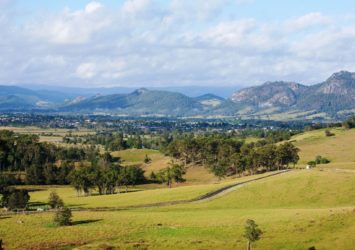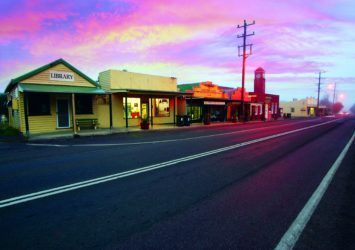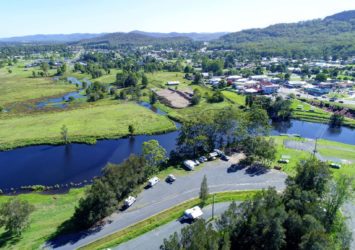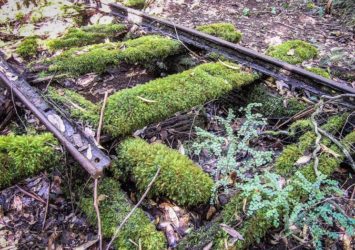The Barrington Coast is where the Australian merino wool industry took its first important but faltering steps.
Explore the pretty valleys and villages of AACo's renowned one million acre estate that’s now part of the Barrington Coast.
Take this relaxed drive to follow the footsteps of the European pioneers from AACo, from Nabiac to Gloucester and Stroud via the Bucketts Way then onto Bulahdelah and Wootton.
Download the Scenic Drives map here.
View this Historical Hinterland scenic drive online here.
Points of interest:
Nabiac
Nabiac sits alongside the Wallamba River and means 'place of the wild fig'. Be sure to explore to quaint shops in the quiet streets off the Pacific Highway, you'll discover the National Motorcycle Museum plus cafes and antiques.
1. Nabiac Skatepark: Something for the kids in the car.
2. National Motorcycle Museum: The National Motorcycle Museum houses in excess of 800 motorcycles and memorabilia relating to motorcycles from 1900 to the present, including a large collection of Australian speedway. The purpose-built museum is privately owned and has over 2,600 square meters of floor space. Some of the favourite machines on display are the Kenilworth scooter (1919), the twin cylinder water-cooled 2 stroke Scott, and the Vincent Black Knight. There is an excellent range from the early 1900s, and a lot of very interesting later machines. Allow an hour or two to have a good look around and read some of the interesting history presented. Books, toys, models, badges, patches and memorabilia are available for sale at the museum.
3. Bullock Wharf: The highest navigable point of the Wallamba River is the place the early settlers built their wharf and used bullocks to drag their loads of timber for shipping downstream.
4. Villa D'Esta Vineyard: Nestled in the gentle rolling hills Villa d'Esta Vineyard is a European-style vineyard producing easy-drinking table wines made by traditional Hungarian winemaking techniques with maturing in oak barrels: chardonnay, chasselas doré and chambourcin plus small plantings of pinot noir, merlot, cabernet sauvignon and shiraz.
Krambach
The village of Krambach boasts beautiful country views and friendly locals you'll meet at the cafes or local pub. And if you love bargain buys, the Krambach Community Markets are on the 3rd Sunday of the month. Initially a beef cattle district, the early pioneers diversified into maize and wheat however this crop was eventually abandoned when disease made it uneconomical. Dairying became the profitable farming standard and there are still productive dairy farms in the region.
Mograni Lookout
Driving from the direction of Krambach, Mograni Lookout is located 5 km east of Gloucester on the Bucketts Way. You’ll find excellent views over the Gloucester valley looking toward the Buccan Buccans (the Bucketts Mountains). Best time for viewing and photographing this striking rock formation is before midday while the sun lights up the eastern face. Facilities include barbecue and picnic tables but no toilets.
Gloucester
Nestled at the foot of the Buccan Buccans (the Bucketts Mountains) Gloucester sits at the junction of 3 rivers in its own scenic valley 8 km wide. First viewed by Europeans in November 1826, the valley was described by AACo's Robert Dawson as being "truly beautiful, like a gentleman's park... furnished with scenes of exquisite beauty". Gloucester District Park is the perfect place to relive this feeling. In the operations of AACo headquartered down the dusty road at Stroud, Gloucester was a mere sheep farm until the early 1900s.
1. Gloucester Visitor Information Centre: Your first stop when visiting any country town should the visitor information centre, you'll find helpful volunteers who can give you much more information than you'll find online. And some local tips and secrets too.
2. District Park: Gloucester District Park is the perfect place to relive the feelings of Robert Dawson: take a stroll along the tree-shaded river and listen to the waters of the Gloucester River babbling over the pebbles on its way from Barrington Tops to the Pacific Ocean.
Stroud
Part of the original grant to the Australian Agricultural Company (AACo), Stroud was established in 1826 as the centre of operations for the country’s growing wool industry. Many of Stroud’s buildings were built by convict labour and today a heritage walk takes you on a journey through the town and Australian history.
Stroud has also become famous in recent years as the home of the International Brick & Rolling Pin Contest. Held in July each year this competition involves the towns of Stroud in Australia, England, Canada and America.
This town represents our connection to the early years of the New South Wales colony. The main street is dominated by the Stroud Hotel a beautiful country pub and alongside are cafes and antique shops. Stroud is the perfect stop on your journey to the Barrington Tops.
1. Stroud Gate: Stroud was the first gated community in Australia. Each evening the Stroud gates were closed to secure the village that contained valuable stores and livestock, all of which belonged to the Australian Agricultural Company. Today the gates are open and welcoming.
2. Court House: This restored Court House built in 1877 houses a collection of historic photos of Stroud and district. It also displays information on the formation of the Australian Agricultural Company in London in 1824, the farm grant of 1 million acres of the Port Stephen Estate and local and family history.
3. Quambi House: This convict-built school and schoolmaster's residence is one of these buildings. Originally built as a two roomed schoolhouse (originally known as Lady Parry's School) about 1831 to accommodate 40 children. A second storey was added to serve as a teachers residence in 1841. The building was acquired by the Anglican Church circa 1850s, with a kitchen annex being added in 1860. The building remained as a school until 1888 when the government school opened. It was then used as a private grammar school until 1900 when it became a private residence. About this time the front porch was demolished and replaced by a full width bullnose iron verandah.
The building was used as a private residence from 1900 until 1973, and it was during its occupancy by the Callow family that the name 'Quambi' ('place of shelter') was first used for the building. Quambi House was purchased and restored in 1975 and converted into a museum by the Stroud Historical Society.
Now listed on the Register of the National Estate, the two storey Georgian style school house/museum displays furniture, clothing, personal and household items, photographs and other objects from the late 1800s to the mid 1900s. The restored, convict built building also houses a collection of historic books from the Australian Agricultural Company.
4. Silo Hill: Silo Hill contains 8 underground silos built in 1841 (6m deep and 4.8m wide) lined with handmade local bricks. They were very successful against weevil and fly moth attack on the local wheat crop. The nearby cannons were manufactured in 1856 and formed part of the Sydney Harbour defences during the Crimean War. They came to Stroud in 1909 as decorative pieces for Stroud village.
Booral
Booral was the premier wheat-growing area of the Australian Agricultural Company's Port Stephens Estate. In 1834 the Booral wharf was constructed at the highest navigable point of the Karuah, one mile south of the village, and the stone ruins can still be seen by boat upstream from Allworth. Booral House was constructed in 1831 on a magnificent site for the AACo's Chief Superintendent and was consider a showplace of the district.
Bulahdelah
Bulahdelah is a country town on the banks of the Myall River near its junction with the Crawford River, named from an Aboriginal word thought to mean "the meeting of the waters". The town is the gateway to the major attractions of Myall Lakes National Park, Bombah Broadwater, Myall River, Bulahdelah Mountain, The Grandis and Bulahdelah Court House.
1. Bulahdelah Visitor Information Centre: Your first stop when visiting any country town should the visitor information centre, you'll find helpful volunteers who can give you much more information than you'll find online. And some local tips and secrets too.
2. Court House Museum
3. Wade Park: Wade Park is the perfect stopover when traveling with kids, they'll love the playground while you set up on the picnic tables.
4. Bulahdelah Mountain Aboriginal Place: This place has cultural, spiritual and historical significance to the Worimi people of the Barrington Coast. It includes walking tracks and lookouts to respectfully explore and enjoy, including traditional tree carvings, a cultural space with seating and fire-pit, and visitor facilities. There are several tracks to explore:
- Boolah-Dillah Track from the car park is a steep walk to the Worimi cultural area where you can rest or picnic.
- Mountain Track from the cultural area leads to the Mountain Lookout for spectacular views over Bulahdelah.
- Ted Baker Track follows the old tramline south to Ted Baker Lookout, which gives panoramic views across the Myall River and coast.
Wootton
Wootton is a small hilltop town surrounded by cattle farms, equestrian enterprises, state forest and national parks. It also boasts an active community based around the community centre plus cafes serving locally grown produce.
Behind Wootton are forests that are perfect for bike riding and trekking. The area is also a great day trip away from the coast.
Wootton Historical Railway Walk: This walk can be found in the Wang Wauk State Forest. This six kilometre walk starts off at Sam's Camp Picnic Area, with Wang Wauk Forest Way marking its halfway point. The first section of the walk takes in rainforest and cleared, grassy areas used by logging vehicles in the early 1900s. The walk follows significant remnants of old logging railways and mossy bridges, passing by waterfalls, creeks and through gully rainforests and magnificent flooded gums, before finishing at the remains of what was once a trestle bridge.
Great Lakes Paddocks Winery
Great Lakes Paddocks is a family friendly destination offering delicious wine, grass-fed angus beef, local produce, music events and private functions. From a casual day of wine tasting and nibbling cheese in the 'back paddock', to social club and tour groups enjoying a hosted tasting and barbecue lunch, or rounding up the herd of Angus cattle for some TLC, hosting a wedding and running music days and fairs.....you'll never know what you'll find.
Coolongolook
It's easy to miss the best of Coolongolook: hidden east of the village is the Coolongolook River, deep forests, farm gates, a winery and meandering country drives. The village is popular with boaters and paddlers as they explore the upper reaches of Wallis Lake.







